Beehive Factory Visit. Beehives, Feeders, Supers, Brood Boxes, Swarm Catchers and more!
Hey everyone, this was one of my most interesting visits ever, in hindsight and knowing what we do know the next visit should probably happen with full bee suits, but as you can see below this chap has a bee veil on, arms exposed, open shoes etc. Either he is rather brave or very experienced?
The reason for our visit here was to buy some equipment and get some advice from folks that are more experienced than ourselves. We bought 3 new supers a whole hive which includes ones super one brood box was strips/foundations more on that here as per wikipedia https://en.wikipedia.org/wiki/Wax_foundation
Here we have my partner and a worker at the factory removing honey combs from a brooder box, you may ask why? These hives were infected by wax moths so sadly the wax needed to be destroyed if not, further contamination would spread. Wax moth normally and luckily only affects weaker and new swarms, the general rule of thumb is that well established strong swarms are not affected by this horrible creature. I recently made a post on wax moth over here https://steemit.com/homesteading/@craigcryptoking/bee-keeping-wax-moth-the-downside
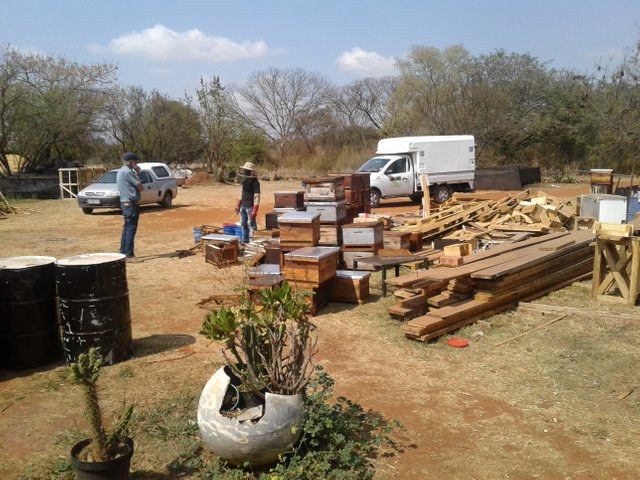
These are brooder frames, The units go into the bottom brooder box where the bees make comb foundation and lay eggs for the natural expansion of the swarm. Generally these frames have installed a small piece of wax foundation at the top around 50mm long just to start the comb for the bees and to give them a general idea as to where the beekeeper wants the combs to be constructed, not that the bees need any help at all they truly are the smartest insect that exists!
These frames as well as the super frames all have a thin wire running along the inside of the frame to give extra support for the foundation wax strip as well as the comb the bees will build onto it!
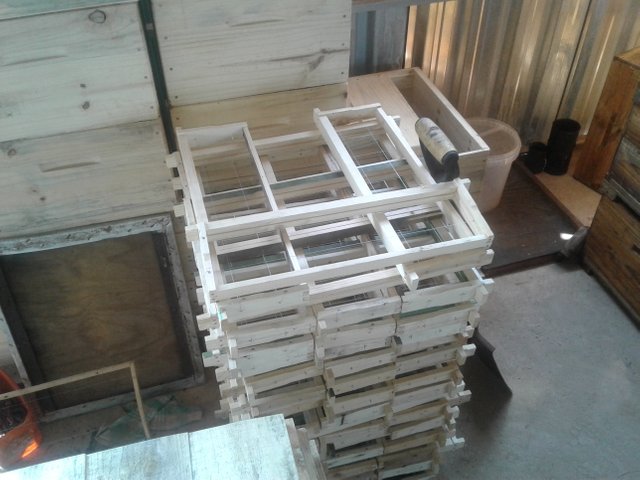
Here we have another angle of the inside of the factory. Those big boxes are all brooder boxes, the super boxes are placed on top of these boxes in the honey flow season and only once the swarm is strong and well established!
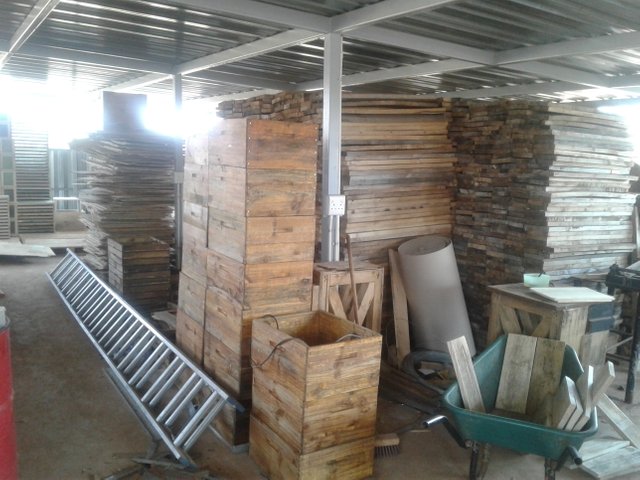
Here we have a full wax super frame. This goes on top of the brooder box in season. Each super box has 10 frames, these are harvested every 6 weeks odd in season when the honey flow is good. The brooder box combs are never extracted those are reserved purely for the bees to reproduce, the super frames one puts on the brooder box is for seasonal honey harvest!
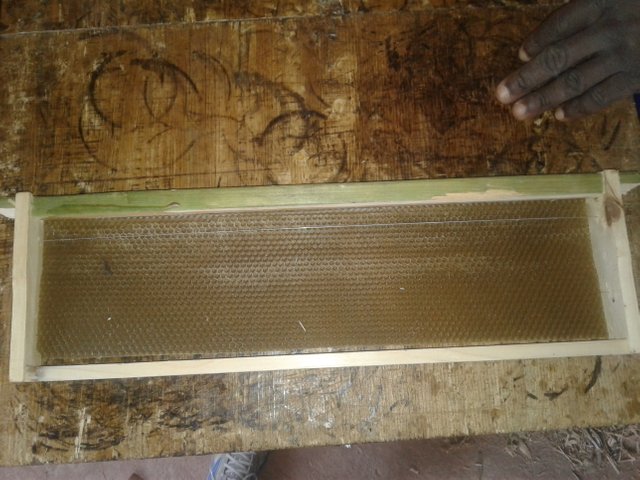
The hive lids are all standard with a tin sheet on top of the unit. Most bee hives are in full sun all day this prevents sun damage to the wooden hive!
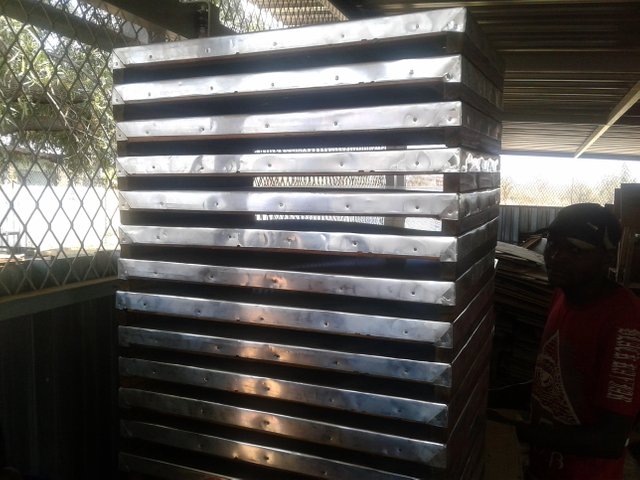
Feeding in the off season. Bees generally in winter and dependent on the area/flora availability etc need to be fed. The food one gives bees in the off season or in the case of South Africa mostly winter varies. Most folks use a strong mixture of sugar water and maybe a little orange juice added. I am not too fond of the sugar water idea as your bees are essentially making a sugar water honey, sugar is not good for man nor beast, so when the time comes for me to feed I will more than likely use a strong mixture of pure raw honey and nutri-feed more on that here https://steemit.com/ghsc/@craigcryptoking/my-quest-in-becoming-a-top-honey-producing-bee-farmer-in-south-africa-step-3
These feeder trays are placed on top of the brooder box with the lid then placed on top of these!
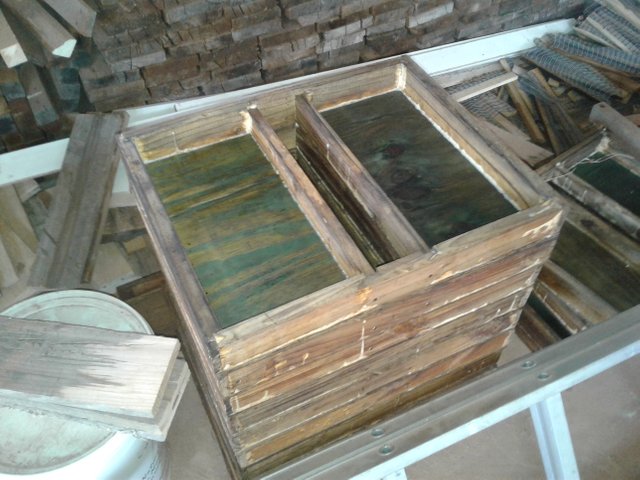
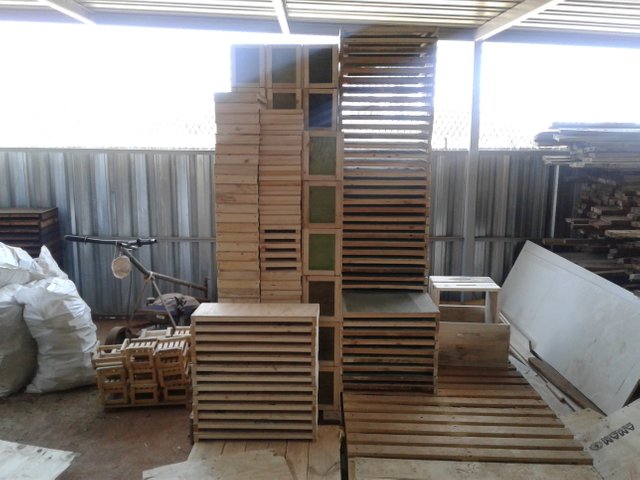
Here the guys are mass producing frames for the brooders and supers in the backdrop untreated (inside the hives no need to be treated) In the foreground we have brooder boxes, these are treated with a product called waxol which is perfect for the adverse weather conditions sun/rain etc and protection of the wooden hives!
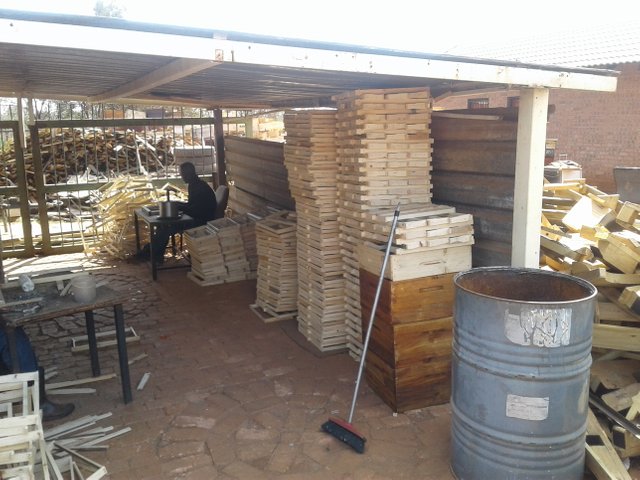
Can anyone have a guess what this is?
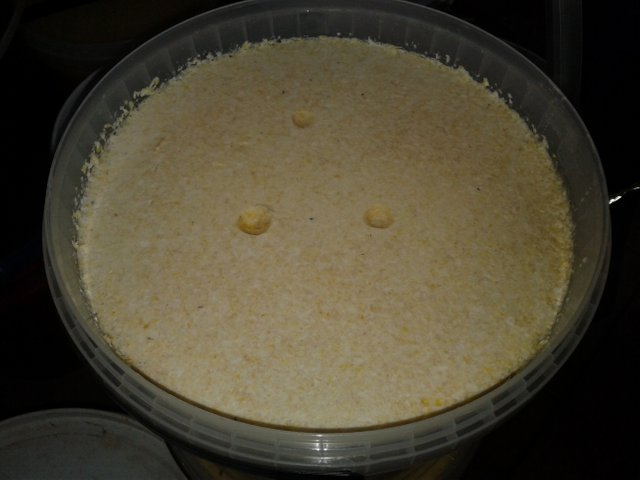
This is a whole 25 kg bucket of creamed honey. This is by far one of the best tasting honey's around and can be made by simply friskly mixing raw honey, generally better done just as it is spun off the comb as this is when honey flows very nicely! A few days later honey tends to get thicker and crystalize !
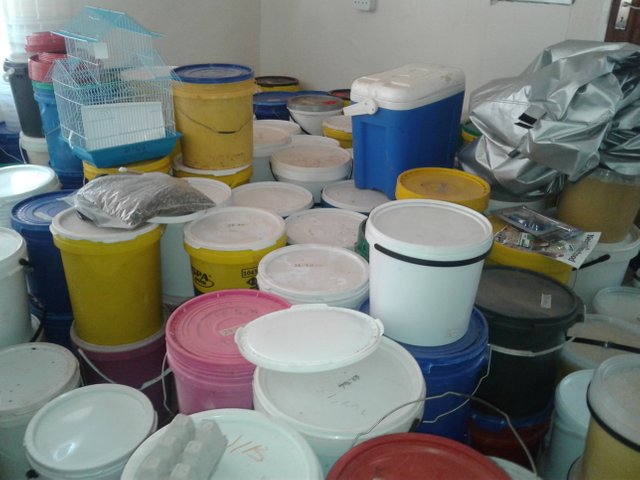
The more hives you have the more bees the more honey and production, many buckets necessary for the safe storage of honey.
Here four different honey flavors from macadamia to sunflower to bluegum and wattle honey all coming from different hive locations and flora species which is rather interesting what a different effect it has on the honey!
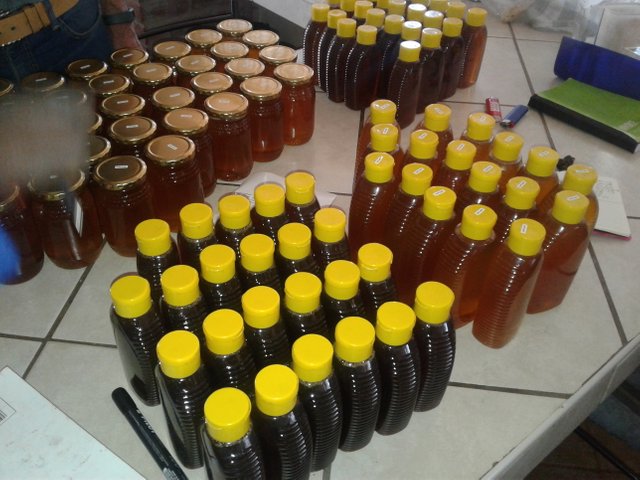
Wax on the comb. This generally demands a rather high price and is extremely good for you. I plan to be doing honey on the comb as well, it should be rather interesting and tasty indeed!
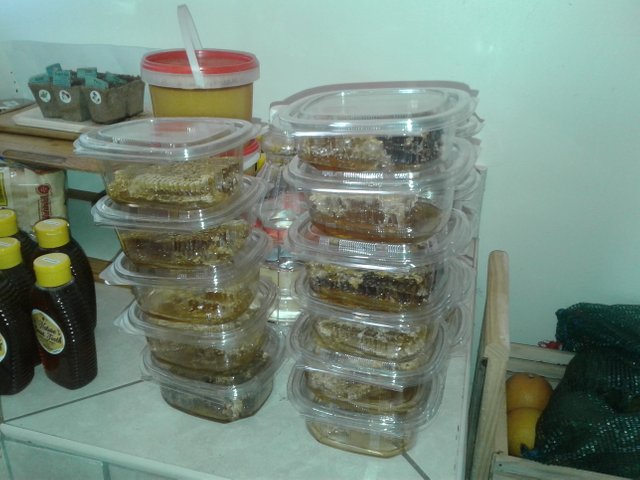
One kilogram buckets of honey same flavors as above the second from the left is the creamed honey, very light in complexion due to the high oxygen levels from the mixing process in the honey!
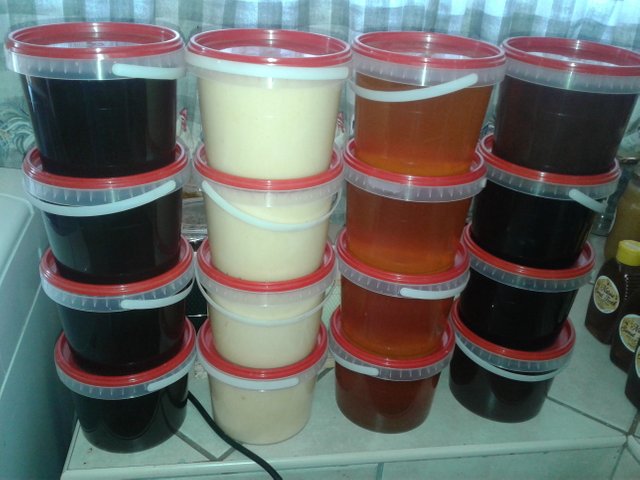
We are going to probably be buying a few of these in future too. These are honey bee catching boxes which are placed all around in the hope of catching new swarms of bees (in swarming season) one can catch directly to brooder boxes (hives) or these. Personally I prefer to catch directly to a hive as they not need be disrupted and moved at a later stage but many folks prefer this option too, we will just see which technique we prefer as time goes by.
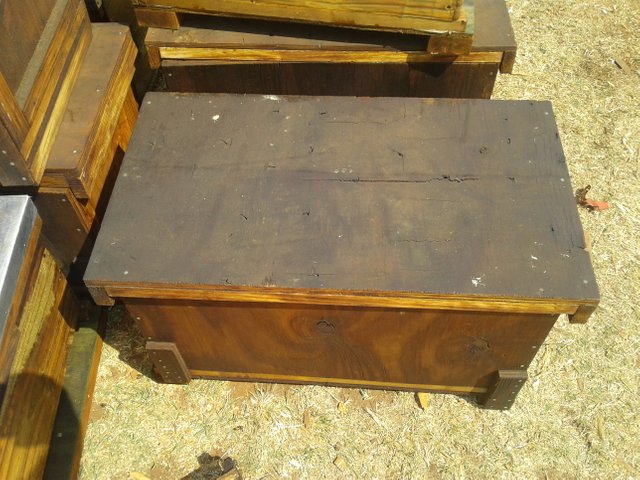
The next bee blog I will be doing I will feature super boxes which I have modified to have windows in, which will be super cool to watch the bees working inside the hives as well as a massive time saving in knowing when to harvest honey without having to take the lid off the hive disrupting the bees. I plan to install a camera on the window too and take some awesome videos and pictures which I shall be posting here to, be sure to stay tuned for that.
Have a super cool and sweet Sunday evening!
Cheer$;)
That is a serious operation. Do you have a beekeeping mentor in your area? There are some places where the nectar flows are consistent enough that you don't have to feed the bees if you are careful not to steal too much honey from them.
I usually give them about a few kilos of dry sugar on a piece of newspaper just as the winter comes to an end. Other than that, they are on their own to find enough to eat. In the early season they don't store any nectar or sugar syrup, so there is no danger of ending up with sugar syrup in your honey crop.
Hey man my mentor is youtube am meeting a few peeps here and there. You been in the trade for some time? I am looking to attract as many swarms as possible can you give me some advice on the best way to do so ? I want to put brooder boxes out with wax and lemon grass oil I hear that works? Cheer$;)
I am just a hobbyist. Wax and a tiny amount of lemongrass oil will do the trick. It also helps to place the traps up off the ground. Do you know where there are some feral colonies? Try to set your traps near a hive that isn't managed and will probably swarm.
Posted using Partiko Android
We have two hives we can collect.. or swarms rather.. How many hives do you have? I hear propolis works wonders to attract swarms?
I have seven managed hives and two feral hives that I keep an eye on. This year I caught two swarms. April and May are our swarm season. Catching swarms is lots of fun, but it is more efficient to manage your colonies to prevent swarming and make increase by splitting hives and giving them queen cells.
Propolis is a good bait. The objective is to make the hive smell like bees lived there. European honeybees like a trap that is 40 L with a 30 mm opening about 3 m off the ground. They are very flexible and not good at measuring, so you can catch a swarm in almost any container. Try to make is dark inside and scented with old comb and propolis.
Lemongrass oil smells a little like the queen pheromone. Don't use too much - just a drop or two. There is a commercial product call Swarm Commander, which is supposed to work even better. I've heard people say that you have to store it in a sealed container in the refrigerator and carefully clean up any drips. People who have left a bottle of it in their truck have come out of the grocery store to find the cab filled with bees.
Your African bees like a smaller hive, or so I've heard. That is good for you. A 40 L box full of bees is hard to handle when you are on top of a ladder.
Where are these two swarms that you are going to collect? A hollow tree? Getting bees out of an established feral hive is quite a trick. Catching a swarm is relatively easy in comparison.
Exciting times! I can feel your excitement from here. I've been really vote happy today so watch this space for my full steem vote, not-so-little brother. You can give me a bucket of honey from your first harvest
Hhehe good plan when you come visit ;)